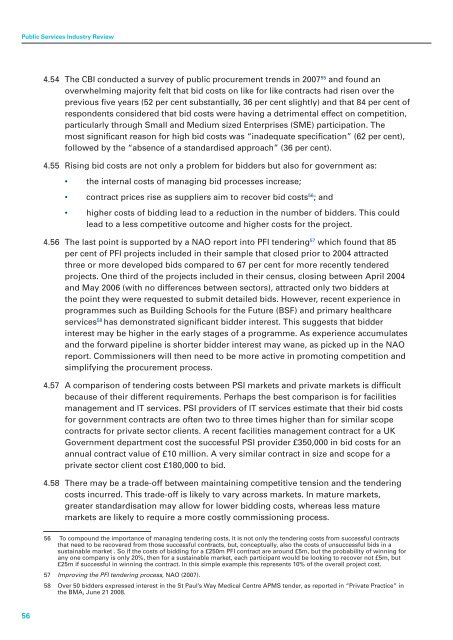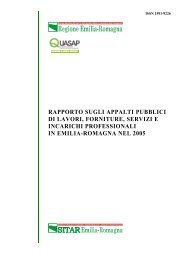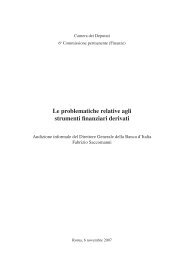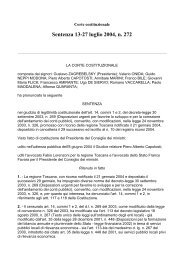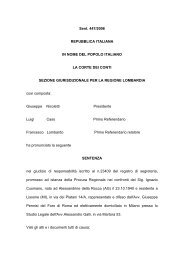Understanding the Public Services Industy
Understanding the Public Services Industy
Understanding the Public Services Industy
Create successful ePaper yourself
Turn your PDF publications into a flip-book with our unique Google optimized e-Paper software.
<strong>Public</strong> <strong>Services</strong> Industry Review<br />
4.54 The CBI conducted a survey of public procurement trends in 2007 55 and found an<br />
overwhelming majority felt that bid costs on like for like contracts had risen over <strong>the</strong><br />
previous five years (52 per cent substantially, 36 per cent slightly) and that 84 per cent of<br />
respondents considered that bid costs were having a detrimental effect on competition,<br />
particularly through Small and Medium sized Enterprises (SME) participation. The<br />
most significant reason for high bid costs was “inadequate specification” (62 per cent),<br />
followed by <strong>the</strong> “absence of a standardised approach” (36 per cent).<br />
4.55 Rising bid costs are not only a problem for bidders but also for government as:<br />
•<br />
<strong>the</strong> internal costs of managing bid processes increase;<br />
56<br />
• contract prices rise as suppliers aim to recover bid costs ; and<br />
•<br />
higher costs of bidding lead to a reduction in <strong>the</strong> number of bidders. This could<br />
lead to a less competitive outcome and higher costs for <strong>the</strong> project.<br />
4.56 The last point is supported by a NAO report into PFI tendering 57 which found that 85<br />
per cent of PFI projects included in <strong>the</strong>ir sample that closed prior to 2004 attracted<br />
three or more developed bids compared to 67 per cent for more recently tendered<br />
projects. One third of <strong>the</strong> projects included in <strong>the</strong>ir census, closing between April 2004<br />
and May 2006 (with no differences between sectors), attracted only two bidders at<br />
<strong>the</strong> point <strong>the</strong>y were requested to submit detailed bids. However, recent experience in<br />
programmes such as Building Schools for <strong>the</strong> Future (BSF) and primary healthcare<br />
services 58 has demonstrated significant bidder interest. This suggests that bidder<br />
interest may be higher in <strong>the</strong> early stages of a programme. As experience accumulates<br />
and <strong>the</strong> forward pipeline is shorter bidder interest may wane, as picked up in <strong>the</strong> NAO<br />
report. Commissioners will <strong>the</strong>n need to be more active in promoting competition and<br />
simplifying <strong>the</strong> procurement process.<br />
4.57 A comparison of tendering costs between PSI markets and private markets is difficult<br />
because of <strong>the</strong>ir different requirements. Perhaps <strong>the</strong> best comparison is for facilities<br />
management and IT services. PSI providers of IT services estimate that <strong>the</strong>ir bid costs<br />
for government contracts are often two to three times higher than for similar scope<br />
contracts for private sector clients. A recent facilities management contract for a UK<br />
Government department cost <strong>the</strong> successful PSI provider £350,000 in bid costs for an<br />
annual contract value of £10 million. A very similar contract in size and scope for a<br />
private sector client cost £180,000 to bid.<br />
4.58 There may be a trade-off between maintaining competitive tension and <strong>the</strong> tendering<br />
costs incurred. This trade-off is likely to vary across markets. In mature markets,<br />
greater standardisation may allow for lower bidding costs, whereas less mature<br />
markets are likely to require a more costly commissioning process.<br />
56 To compound <strong>the</strong> importance of managing tendering costs, it is not only <strong>the</strong> tendering costs from successful contracts<br />
that need to be recovered from those successful contracts, but, conceptually, also <strong>the</strong> costs of unsuccessful bids in a<br />
sustainable market . So if <strong>the</strong> costs of bidding for a £250m PFI contract are around £5m, but <strong>the</strong> probability of winning for<br />
any one company is only 20%, <strong>the</strong>n for a sustainable market, each participant would be looking to recover not £5m, but<br />
£25m if successful in winning <strong>the</strong> contract. In this simple example this represents 10% of <strong>the</strong> overall project cost.<br />
57 Improving <strong>the</strong> PFI tendering process, NAO (2007).<br />
58 Over 50 bidders expressed interest in <strong>the</strong> St Paul’s Way Medical Centre APMS tender, as reported in “Private Practice” in<br />
<strong>the</strong> BMA, June 21 2008.<br />
56


